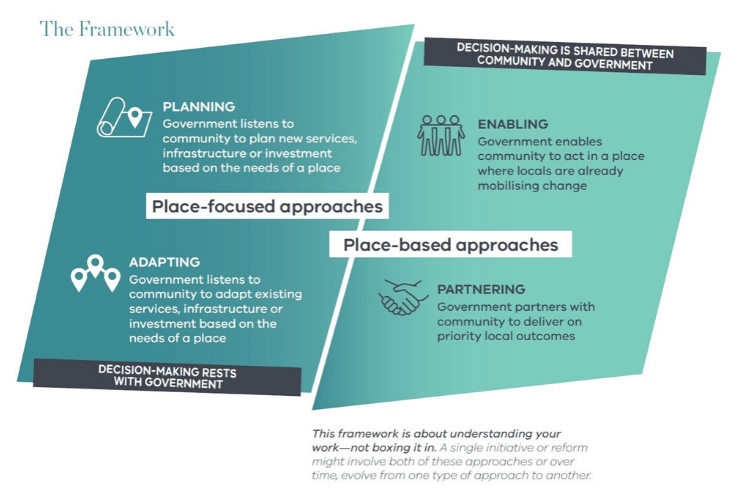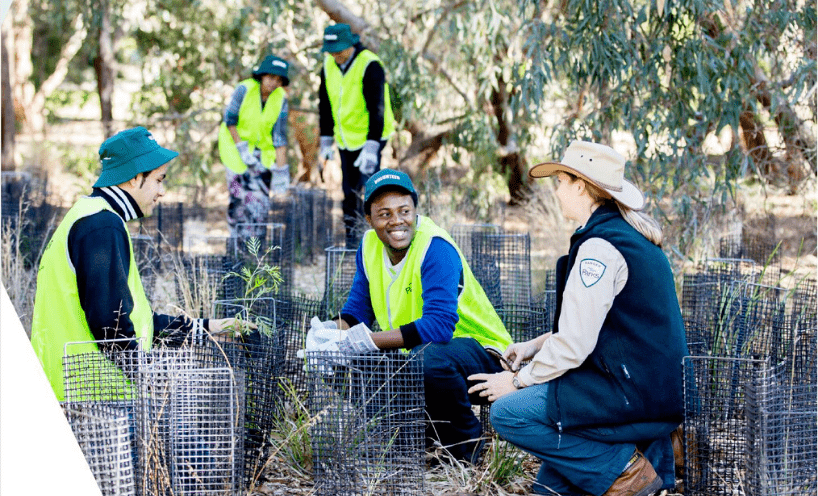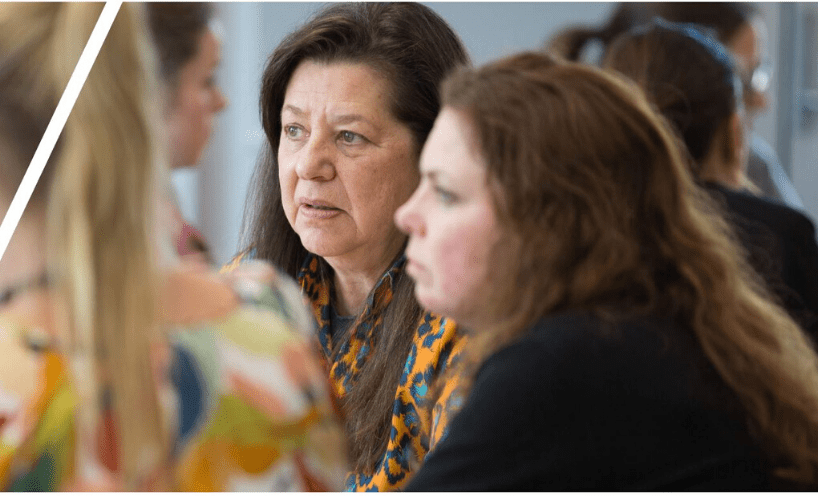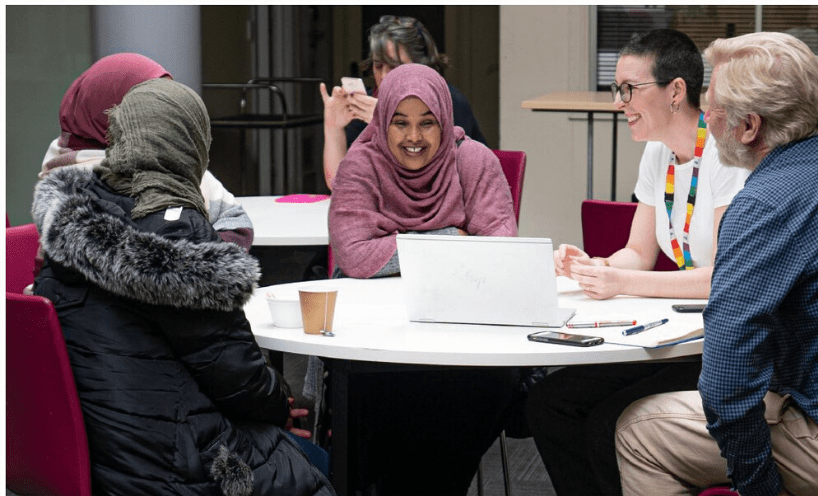A whole of government framework for understanding place-based approaches
This framework provides a common language for different ways of working in place.
It supports clear communication within government and with the community about what we are trying to achieve and how we will go about it.
The framework is not intended to box your work into a single quadrant. Instead, it describes how different ways of working with communities
are appropriate for different circumstances.
Working well in place means being responsive to the needs of the local community—starting at the local context and shifting your ways of working as the context changes.
This means a single initiative or reform might involve more than one of these ways of working and, over time, will often evolve from one to another.
The Framework
Place-focused approaches
Place-focused approaches tailor services, infrastructure and investment to ensure they are meeting local needs.
They might involve collaborative practices like co-design or advisory groups, but ultimately, government has control over the objective, scope and implementation.
What are place-focused approaches?
Government delivers many services, infrastructure and investments in local communities.
Place-focused approaches recognise this and engage with communities to understand how the design and delivery of these activities can best meet their needs.
Across the Victorian Government, it is best practice to ensure our work is meeting the needs of local communities.
By engaging communities to understand how services and projects can work best for them, we can improve the effectiveness and outcomes of our support and investment.
When should you use a place-focused approach?
This approach can be applied to any government service, infrastructure and investment. We might use them where:
- a broader issue or trend is impacting different communities in different ways
- we know we have the tools at our disposal to respond effectively with government service delivery, infrastructure or investment
- community input or developing a shared understanding of local conditions would improve the effectiveness of a planned service response or infrastructure project
- community is willing and can be supported to participate in consultation and design processes
Who is involved?
- Government leads the process and is in charge of its design. Government is also in control of implementation, either by directly delivering services and initiatives or through funding and reporting requirements.
- Community is consulted and involved in the process. Their needs guide the design and ongoing implementation of services and infrastructure. They may share their views through consultation processes, co-designing elements of a project or sitting on advisory groups.
- Local government is a critical player and may inform or partner in design and delivery in local areas.
- Traditional Owners should be meaningfully engaged throughout the process and enabled to make decisions in accordance with principles of self-determination.
- Other stakeholders such as service providers, businesses and philanthropy are engaged as required depending on the needs of the project.
How does government use place-focused approaches?
There are two main ways that government ensures its activities are meeting local needs: planning and adapting.
Planning
Government listens to community to plan services, infrastructure or investments based on the needs of a place.
Used when there is an area in the state that is experiencing, or will experience, significant demographic changes, or will host major infrastructure of investment projects.
Case studySunshine Planning PrecinctSunshine |
|
Government’s major rail investment in the Sunshine area presented an opportunity to engage with community to plan new infrastructure and services that optimise investment and support social and other economic outcomes. Government consulted with the City of Brimbank, as well as local education and health providers, to develop an Opportunity Statement outlining the intent to make Sunshine an area of strong job growth and high-quality and affordable housing. A roadmap is being developed within government with implementation options for core planning, investment, social inclusion and value capture. Place-based approaches will also be important to guiding delivery and implementing the precinct plan. With the release of a public statement in 2020, broader stakeholder and community engagement will inform planning and may reveal opportunities for government to partner with community or enable community action. By tailoring government infrastructure investment to community needs and the local environment, the Sunshine Precinct is a good example of place-focused planning. Successful delivery of this precinct will involve ongoing collaboration with community, industry and landowners and businesses. |
Case studyCommunity bushfire planningStatewide |
|
Almost a third of Victorians live in regional areas, and the number of visitors to the state’s coasts and rural areas is growing. This exposes more people to bushfire risk. Managing this is an ongoing and shared responsibility, with the best decisions are shaped by the people they affect. Safer Together combines knowledge and experience of local communities with the expertise of fire and land agencies, to plan the most effective ways to reduce fire risk across all land tenure. Community First Projects are building capability of land and fire agency staff, providing eight community-based bushfire management officers working across 22 communities to:
This planning and engagement occurs all year round and provides communities with greater input over where and when planned burning should occur. As a result, firefighters are better able to work with local communities, land and fire agencies and ensure their activities to reduce risk are complementary. These activities are a good example of place-focused planning. They involve local community members so they have a greater say on how to reduce the risk of bushfire, including where and when planned burning should occur. Likewise, the activities seek to promote bushfire risk management as an ongoing and shared responsibility by leveraging the knowledge, experience and understanding that communities hold. |
Case studyLevel-crossing removalsStatewide |
|
Government is removing 75 dangerous and congested level crossings across Melbourne by 2025. The project will improve safety, create jobs and reduce travel time around our city for public transport users, pedestrians, The project is benefiting from extensive community involvement in planning. This can be seen in the design of the rail bridge to remove all level crossings between Bell Street in Coburg and Moreland Road in Brunswick. The design will create 2.5 km of public parkland and open space, with artist impressions reflecting local feedback collected from survey responses and drop-in sessions. Level crossing removals are a good example of a place-focused approach to planning. Community members help to shape the implementation of a major government infrastructure project by being consulted with and invited to share their views on how this will affect their local area.
|
Adapting
Government listens to community to adapt existing services, infrastructure or investment based on the needs of a place.
Used when a local area has a specific need that services or infrastructure can help meet, and tailoring to local context can improve the effectiveness of government's response.
"At the heart of all successful place-based partnerships are communities that provide maximum practicable input in all decision-making."
Case studyThe Orange DoorStatewide |
|
The Orange Door is a free service being rolled out across the state. It is for adults, children and young people who are experiencing, or have experienced, family violence and families who need extra support with the care, development and wellbeing of children. The statewide concept and service model outlines the functions of The Orange Door, but has been developed to allow for local tailoring and flexibility for continued improvement and development. In addition to statewide oversight and consultation, local engagement and governance mechanisms inform the establishment and operation of The Orange Door in each area. The Orange Door is delivered through a partnership between government and local community service organisations. People with lived experience of the service system (including victim survivors of family violence) informed the development of the statewide concept and service model, and understanding of client experience informs the ongoing improvement of the service offering in each area. The Orange Door is a good example of adapting, because the service has been designed to provide for a consistent level of service statewide as well as local adaptations. As The Orange Door is rolled out, Family Safety Victoria is learning more about the challenges and strengths of implementing an adaptable model which can be leveraged by other areas of government. The 2018 evaluation of The Orange Door found that there were opportunities to clarify operational issues where statewide standardisation is needed, and what can be localised for each area. The evaluation also advised that Family Safety Victoria becomes a more overt system steward to lead The Orange Door through the implementation phase. Family Safety Victoria is working with partners to strengthen consistency across workflows, processes and practice in The Orange Door. |
Case studyLearning places and education plansStatewide |
|
In 2016, the Department of Education and Training (DET) introduced the Learning Places model, which was established within 17 areas that align with local government areas across DET’s four regions. Under the model, schools, early childhood services and training organisations work on local outcomes with regional DET offices which link to DET’s central office and relevant service providers. In doing so, Learning Places facilitates cross-government initiatives and integrated service provision. The service delivery model allows localised, tailored and integrated decision-making, service and support partnerships and community central to improving the education system. Place-Based Education Plans, in seven communities across Victoria, support the Learning Places model and enable the department to collaborate with local communities and education partners to transform local education outcomes in areas with complex challenges. These strategies, particularly the Education Plans, are a good example of adapting universal service delivery. They have been designed to draw on and adapt to local contexts, so they can be applied to diverse communities across Victoria. In delivering the plans, DET is learning more about the challenges and strengths of implementing an educational model that can be adapted to the unique challenges and priorities of a local community - which can be leveraged by other areas of government |
|
Case study DELWP community charter Statewide |
|
The community charter of the Department of Environment, Land, Water and Planning (DELWP) The charter’s commitments set out what individuals and communities can expect from the department. Its commitment to ‘be available’ includes working with a place-based community focus by engaging with and being visible in local communities. DELWP is also committed to respecting the way communities want to work with them and adapting their approach to local needs. Through the charter, DELWP recognises and harnesses Victorian communities in delivering services to support liveable, inclusive and sustainable communities and thriving natural environments. The charter is demonstrated through the Loddon Mallee Climate Change Adaptation program. In this program, local communities will develop and drive their adaptation actions and strategies by participating in a range of initiatives designed to forge strong partnerships and learning networks, including:
DELWP’s community charter is a good example of adapting the way government operates to respond to the needs and views of local communities. It demonstrates how DELWP will be visible in local communities and talk to community members where they live, work and play. The charter is the beginning of DELWP’s work to deliver services that support thriving environments and communities. It engages community members to communicate openly and honestly about their issues and aspirations. DELWP will work with communities to make sure the charter delivers at a practical level throughout Victoria, by inviting community feedback and hearing their experience, to make sure communities feel included and that they are part of the decision-making process.
|
Place-based approaches
Place-based approaches go beyond listening to the community to inform our business: they are initiatives designed around the specific circumstances of a place and enable local people and organisations to make decisions when defining, designing and implementing a response.
What are place-based approaches?
Place-based approaches target the specific circumstances of a place and engage the community and a broad range of local organisations from different sectors as active participants in their development and implementation.
They are focused on shared outcomes and, crucially, they require us to partner with local people and organisations when defining and working towards these outcomes.
When should you use a place-based approach?
Place-based approaches are not suitable for all circumstances— they should complement government services, infrastructure and investment when these levers alone cannot be effective in meeting
local needs. We might use them where an issue or opportunity:
- is multifaceted, complex and concentrated in a place
- cannot be addressed through services, infrastructure or investment alone—existing government initiatives have not had the desired impact
- does not have a clear solution and requires the active involvement of local people and organisations to discover and develop meaningful responses
- requires a whole of government or whole of community response
- requires a cross-sectoral response
- requires a long-term response.
Who is involved?
Community is the driving force. Community leads action or is an equal partner with government in designing and implementing an initiative focused on something that matters to them. They are supported to partake in decisions about design and implementation.
Government can partner with community or enable their leadership and action. Government provides resources, knowledge and connections to support the initiative.
Local government is an essential player partnering with community or as a key enabler to their leadership
and action. Its resources, knowledge and connections are important to support an initiative.
Traditional Owners should be meaningfully engaged throughout the process and enabled to make decisions in accordance with principles of self-determination.
To be truly whole of community, a broad range of stakeholders - different levels of government, service providers, academic institutions and philanthropic organisations - will be actively engaged in the initiative. Business and employers are often key partners who are well-connected with local communities and hold levers to boost local growth and employment, which have strong links to social, economic, and wellbeing outcomes that are key to many place-based approaches.
How does government support place-based approaches?
There are two main ways that government supports place-based approaches: partnering and enabling.
Partnering
Government partners with community to delivery on outcomes agreed locally.
Often used to enable collaborative responses to shock or trigger event in a local area (such as a natural disaster, economic change or emerging social issue.
May be used where there is a locally concentrated issue or opportunity, but community does not yet have the connections and resources to respond without support.
Case studyMetropolitan and regional partnershipsStatewide |
|
The Metropolitan and Regional Partnerships create opportunities for the community to influence local decisions and shape their future. The partnerships facilitate the identification of local priorities, before presenting these priorities to the Regional and Suburban Partnership Committee of Cabinet. The partnerships include representation from business, the community and all three levels of government. Coordinating government responses helps to improve the liveability, prosperity and sustainability of Victoria’s suburbs and regions. These partnerships provide a chance for government, business and communities to collaboratively drive change by identifying opportunities to improve social, economic and environmental outcomes. Healthy Heart of Victoria (HHV) is working to improve the health of people in the Loddon Campaspe region – the ‘heart’ of Victoria. HHV is supported by the Loddon Campaspe Regional Partnership, the Department of Health and Human Services and the six Loddon Campaspe Local Government Areas. Collaborative decision making has been central for HHV, resulting in a codesigned, community led initiative that is supported by an Implementation Framework. HHV brought together 96 people from 20 different organisations, with over 500 hours spent developing and undertaking workshops across the region. This resulted in a co-designed, regionally owned, implementation model with three components:
The Metropolitan and Regional Partnerships, and HHV, are a good example of partnering because they collaboratively respond to local issues and opportunities that communities identify themselves. Communities and government share decision-making authority to actively involve community members in delivering locally agreed outcomes which vary and are driven by local circumstances. |
Case studyOur placeAt 10 schools across Victoria |
|
Our Place is a place-based partnership approach to delivering education and family services to communities facing disadvantage. In 2012, the Colman Foundation partnered with DET and invested in Doveton College to deliver the Our Place model. Our Place seeks to integrate a school and early childhood centre with facilities where parents and families can access early childhood, school and adult education services. Delivery of these services is facilitated by the Colman Foundation and provides families with access to a range of education and support services at a single location. After eight years of implementation, the results at Doveton College are encouraging and include:
Based on the success of the Our Place model, DET has entered into a ten-year partnership with the Colman Foundation to deliver the Our Place model at 10 sites across Victoria. The Our Place model is an example of partnering, where the Colman Foundation works with the community and responds to the identified needs to deliver tailored support for children and their families. The model recognises that schools are at the centre of the community, and by working in partnership with local council and other service providers, creates an integrated community resource that supports children and their families to succeed. |
|
Case study Latrobe Valley Authority Gippsland |
|
The Latrobe Valley Authority (LVA) was established in November 2016 following the announcement that the Hazelwood Power Plant and Mine would close in March 2017. Initially, the LVA worked with the community to support immediate worker transition needs with planning in mind to improve economic, social and environment outcomes for the Latrobe Valley community. While maintaining a focus on job creation, the LVA is now moving toward region-wide, long-term strategic growth opportunities to set the region up for a strong future. For example, the LVA has adopted a Smart Specialisation strategy to support the Gippsland region to identify key growth sectors and implement a strategic approach across food and fibre, new energy, health and wellbeing and visitor economy. By encouraging collaboration and innovation, the LVA has improved business conditions to bring more jobs to the region and build infrastructure that meets community needs (and creates jobs in the process). This collective work has already resulted in more than 2,500 new jobs and helped generate more than $99 million of private investment in the Latrobe Valley. The LVA is a good example of partnering because it draws on the best ideas and aspirations of those who live in the region and drives coordinated action across all levels of government to achieve shared outcomes. By listening, learning and understanding the local community, the LVA has instilled local pride and ownership and evolved how it works over a 4 year period. The LVA work highlights the importance of partnerships and building relationships at the local level, in response to a trigger event, to design and deliver meaningful outcomes for the region’s future. As community readiness and capacity grows, there is an increasing focus on how the government’s role evolves from supporting implementation to enabling the community to lead on prioritising its key needs. |
Enabling
Government enables community to act in a place where locals are already mobilising change.
Often used where a community is leading change towards an outcome that aligns with government priorities and government support can meaningfully assist the initiative to achieve its objectives.
" At the heart of all successful place-based partnerships are communities that provide maximum practicable input in all decision-making." Centre for Community Child Health, Royal Children’s Hospital
Case studyCommunity support groupsDandenong, Melton and Wyndham |
|
Community Support Groups (CSGs) work with culturally specific communities to strengthen services for individuals who may be at risk of youth disengagement or antisocial behaviour. Local conditions influence the CSGs, which are funded by government to:
The CSGs also build capacity to make services more culturally appropriate and responsive to the needs of the communities with which they work. The CSGs vary in their emphasis between locations, but all use community-led, place-based prevention and early intervention approaches to build protective factors to support young people and mitigate against early factors that lead to youth disengagement. Government funds community-led auspice agencies, staffed by community members, to oversee the day-to-day operations of the CSGs. At each site, Local Reference Groups (LRGs) advise the auspice agency and help to develop and prioritise activities and programs. LRG membership includes community members and government representatives from relevant departments/agencies. CSGs exemplify enabling—the flexibility to work with communities and on their priorities. CSGs provide an example of how government, alongside local leadership, can find opportunities to meaningfully assist community initiatives that are already underway. |
Case studyCommunity revitalisationFlemington |
|
The Flemington Works project was established through the support of the Victorian Government to tackle complex, systemic barriers to employment and economic participation for Flemington public housing estate residents - particularly women and young people - who experience some of the highest levels of social and economic disadvantage in Victoria. Delivered by the Moonee Valley City Council (MVCC), the project works with residents who are active participants in co-defining issues and co-designing and delivering solutions. Activities are coordinated at the Community Centre, which facilitates support services and social events. The approach emphasises building relationships, networks and trust to establish community-led, long-term responses to entrenched social and economic exclusion. Initiatives to support pathways to employment, micro-entrepreneurship and community leadership have been complemented by collaboration with local industry and Jobs Victoria. The project has also driven a significant change agenda to reform the council’s social procurement and recruitment processes. Flemington Works also exemplifies enabling because it actively involves communities in co-defining, co-designing and delivering solutions to improve economic participation. Flemington Works is an example of how state and local government and communities can draw on local knowledge, strengths and relationships to address significant and geographically specific social and economic disadvantage.
|
"Place-focused approaches work when we know what the answers are. When faced with complex challenges and when we don’t know the answer, place-based approaches offer a platform for finding these solutions together." Centre for Community Child Health, the Royal Children’s Hospital, Melbourne (2011). Policy brief: Place-based approaches to supporting children and families.
Case studyGunaikurnai Land and Waters Aboriginal corporation |
|
In 2010, the Victorian Government committed to collaborate with Gunaikurnai Land and Waters Aboriginal Corporation (GLaWAC) to establish a natural resource management (NRM) and cultural heritage enterprise to be owned by GLaWAC and to employ Gunaikurnai People to work on Aboriginal title and other lands. The government worked with GLaWAC to develop and implement business and marketing plans, establish a separate legal entity and to incubate the Gunaikurnai NRM and cultural heritage enterprise. GLaWAC has led significant cultural training, recruitment and retention programs which requires the investment of time and resources. GLaWAC has also worked hard with partners to improve procurement processes. The NRM enterprise is now commercially viable and employs Gunaikurnai and other Indigenous persons. GLaWAC and the Gippsland Environment Agencies (GEA) are signatories of a Partnership Agreement to commit to work together towards shared objectives and mutual opportunities that meet respective goals. They share four common objectives:
GLaWAC and GEA agree that to achieve these shared objectives, they will work together to share strengths, build opportunity and develop close working relationships that benefits all partners. All 14 signatories to the Partnership Agreement commit to an annual planning cycle and an individual partner action plan with quarterly meetings, regular review and open communications. The partnership between GLaWAC and the GEA is a good example of how communities that already mobilising for change can be enabled to work towards a shared outcome with government. The GLaWAC play a key role in decision during quarterly meetings, where they and several government and community groups in the area can plan and review the actions they are jointly taking. |
Updated




